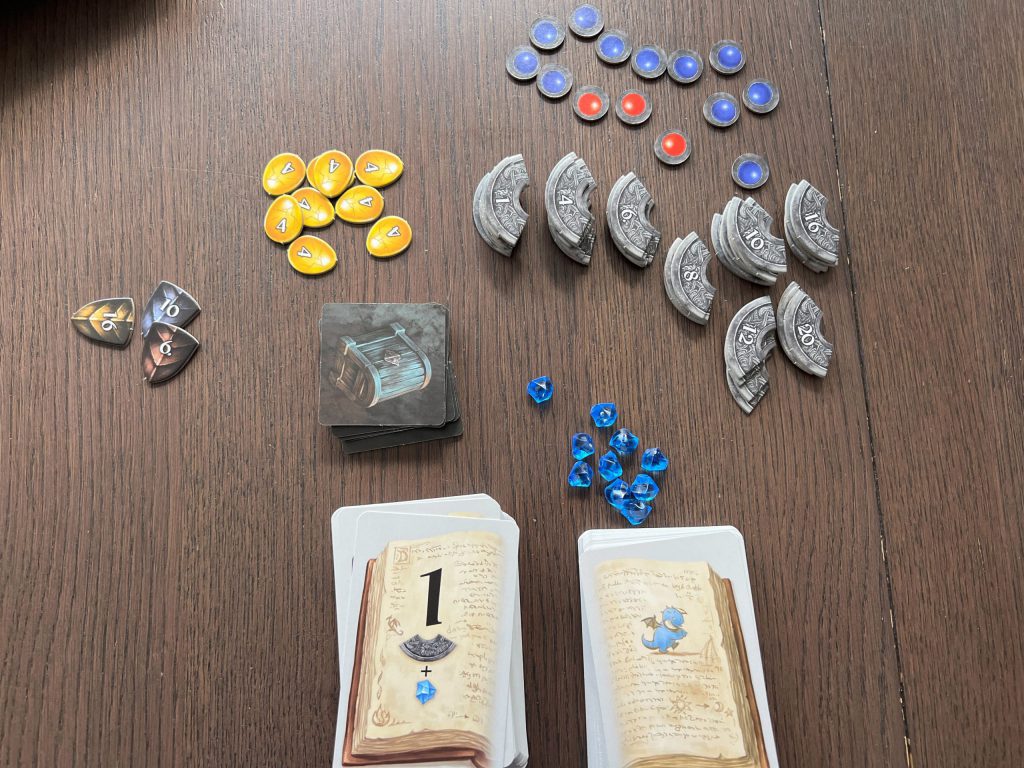Dragonkeepers challenges you to control a shared spellbook to herd dragons
Herd dragons and complete magical amulets and gems in order to win in short and approachable Dragonkeepers.
There aren’t too many games that come in A4-sized boxes and promise a humble playtime of 20 minutes, especially not ones that scale for 2-4 players. Dragonkeepers isn’t conservative in its time estimate either: It’s quick to learn and easy to master. It also happens to include one of the better rulebooks that I’ve read this year.
Yeah, yeah, I get it… praising the rulebook is a bit weird. However, the rules are split into two booklets (one with reiterative tips on structure and advanced play rules) and don’t stray too hard into example play. In fact, unlike most rulebooks, there are only two areas that could have been a little clearer — that every player gets to have a shot at herding dragons before the turn shifts, and that certain amulets are face up. Both of these are discussed well enough in the book but aren’t reiterated as well as they maybe could have been. As a reluctant rules guy, I was really happy to discover that I actually understood the entire game by the time I’d finished my first read of the rules… something that doesn’t even happen with certain party games or kid games.

Anyway, enough about the rules. Dragonkeepers is an incredibly intuitive game that has opportunities for a little bit of accidental, collateral sabotage and a little bit of room for cunning as you race to rack up the highest score before a certain number of amulets have been completed. The play area features two back-facing decks of cards, forming a book that denotes which dragon type and how many dragons may be placed as a valid move (as well as the reward you get for doing so). Players can change these by, on their turn, drawing the piles in front of them (to a total of three cards) and placing one of their cards over a page they’re not happy with. Each dragon card has a different coloured dragon on the back but also has a number (as indicated on the front, and — obviously — on the back). So there’s plenty of room for chaos as you change the requirements to suit you.
Perhaps most importantly though, there are four different colours of dragons, ignoring wildcards, and most players will only be able to play two of the colours by the end of their game of Dragonkeepers. This is because when you herd dragons you do so into piles, and if a dragon colour is flanked on both sides by another colour then you can no longer play them. If you play strategically and only collect two colours of dragons for the majority of the game, then you can make some really powerful moves by flipping the colour to something that others can’t access on your turn.

This means that the spellbook will change a lot (not just because of the drawing of cards either) during a game, however, if it runs out before players have collected and completed enough amulets then the end of the game triggers early. That’s something that most will want to avoid as you don’t score by simply collecting dragons, but instead by collecting amulet pieces, the gems that fill them and golden eggs. Golden eggs are an incredibly innocent-seeming reward, however, if you have the most at the end of the game then one of yours is worth four times the value at a whopping 16 points.
Dragonkeepers is incredibly simple to set up and play, and while the artwork is a little dated it still looks charming and the pieces are easily identifiable. It’s also a great warm-up game for a nervous group, or those about to embark on a bigger game. I love the idea of different designs on the back to keep decks separate, but there’s a whole lot to love here.
Dragonkeepers is available now from the Thames & Kosmos store.
Comments are closed.